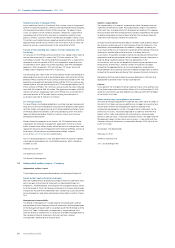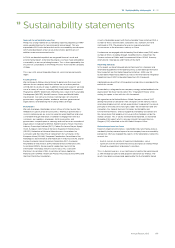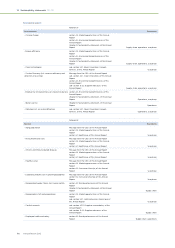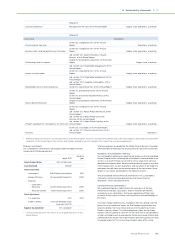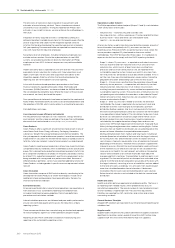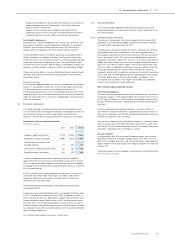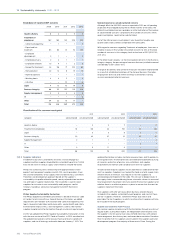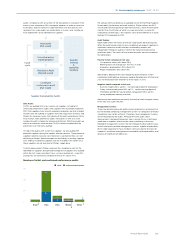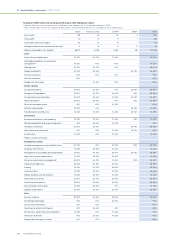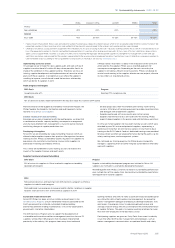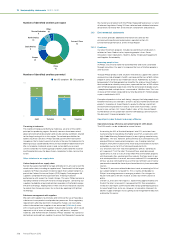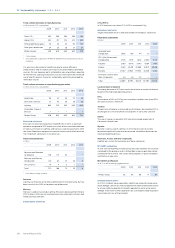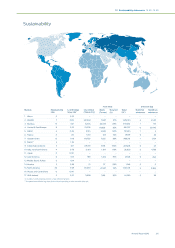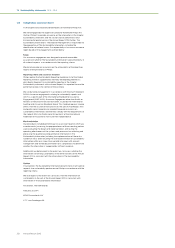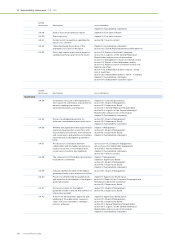Philips 2013 Annual Report Download - page 206
Download and view the complete annual report
Please find page 206 of the 2013 Philips annual report below. You can navigate through the pages in the report by either clicking on the pages listed below, or by using the keyword search tool below to find specific information within the annual report.
13 Sustainability statements 13.2.2 - 13.2.2
206 Annual Report 2013
production, performance management and environmental issues. This is
then used to develop a tailor-made action plan with each supplier, based
on improved dialogue between management and employees. Suppliers
receive support over a period of up to 24 months, and the cost of the
program is shared between the supplier, Philips, and the IDH.
In 2013, IDH was extended from the Pearl River Delta Area to include the
Yangtze River Delta area. As of year-end 2013, the program covers 52
suppliers to Philips, Apple, Nokia, Dell and Hewlett-Packard. A total of 15
Philips suppliers are now involved in the program, seven in the Yangtze
River Delta area and eight in the Pearl River Delta Area, covering around
17,000 employees. Together with other branded goods manufacturers, we
are going beyond a supplier audit. In order to ensure a worthwhile output
we are also working together with suppliers and the IDH program team to
identify the top three improvement actions, and we are monitoring
progress closely. Suppliers such as ‘company B’ are starting to see the
benefits of this program.
IDH
2013 Goals Progress
Increase number of participating Philips suppliers from 7 to 15 suppliers
15 suppliers are now participating. Another 5 were invited and are in the process
of enrolling
Each IDH supplier identifies its top 3 improvement actions
All 15 suppliers completed their Entry Point Assessments and identified
improvement areas and 11 suppliers defined their top 3 improvement actions and
completed development of their work plans
2014 Goals
Increase number of participating suppliers to 20
All participating suppliers identify their top 3 improvement actions and develop
their work plans
70% of all identified top 3 improvement actions implemented by end 2014
IDH case study
B is a company based in Hong Kong, which has an electronics factory
located in Dongguan, China. As a Philips supplier, B has been involved in
the IDH Electronics Program since January 2013.
B has implemented a series of improvement plans in dierent areas,
including worker-management communication, workers’ welfare and pay,
health and safety, factory facilities and production. These improvement
actions have resulted in increased productivity and greater employee
satisfaction.
To improve worker-management communication, for example, B has set
up a factory improvement team made up of front-line production workers,
departmental representatives and managerial sta. B’s management
believes that talking directly to front-line workers gives a more accurate
picture of what is going on in the company than hear-say reports that are
passed up through the organizational hierarchy. The team structure helps
to facilitate B’s cultural values of mutual respect and open
communication.
In the coming years B’s management will continue their active cooperation
and dialogue with employees. Challenges will be identified jointly through
constructive dialogue facilitated by the IDH Program.
Issues further down the chain
Conflict minerals
In line with Philips’ commitment to supply chain sustainability, we feel
obliged to implement measures in our chain to ensure that our products
are not directly or indirectly funding human atrocities in the Democratic
Republic of the Congo (DRC). We are concerned about the situation in
eastern DRC where proceeds from the extractives sector are used to
finance rebel conflicts in the region. Philips is committed to address this
issue, even though it does not directly source minerals from the DRC. The
supply chain for the metals of concern consists of many tiers, including
mines, traders, exporters, smelters, refiners, alloy producers and
component manufacturers, before reaching Philips’ direct suppliers.
Philips has committed not to purchase raw materials, subassemblies, or
supplies which we know contain conflict minerals that directly or indirectly
finance or benefit armed groups in the DRC or an adjoining country. Philips
works towards the following goals:
• Minimize trade in conflict minerals that benefit armed groups in the
DRC or an adjoining country
• Enable legitimate minerals from the region to enter global supply
chains, thereby supporting the Congolese economy and the local
communities that depend on these exports.
What are conflict minerals?
Conflict minerals are defined in the US Dodd-Frank Act as tin, tantalum,
tungsten and gold. They can come from many sources around the world,
including mines in the DRC which are estimated to provide approximately
18% of global tantalum production, 4% of tin, 3% of tungsten, and 2% of
gold. These minerals may end up in many dierent products such as cars,
planes, chemicals, jewelry, packaging, and electronics equipment.
Collaboration with dierent stakeholders
We believe that industry collaboration and stakeholder dialogue are key
to creating impact at these deeper levels of our supply chain. Since 2008
Philips is actively contributing to the Conflict Free Sourcing Initiative, a
joint eort founded by a coalition of leading electronics companies from
the industry organizations EICC and GeSI (formerly called the “EICC-GeSI
Extractives Work Group”). Over 120 companies participate in this initiative
today, and we have formed partnerships with other leadership groups
from across industries, government and civil society. The Conflict Free
Sourcing Initiative provides information on conflict-free smelters and
refiners, common tools and standards to collect supply chain information,
and forums for exchanging best practices. It is a multi-sector, multi-
stakeholder network, and reduces the need for duplication of eorts
across the many sectors that are using these minerals. See also
www.conflictfreesmelter.org
As we have been doing for years, we continued in 2013 our engagement
with relevant stakeholders including the European Parliament, other
industry organizations and local as well as international NGOs in Europe
and the U.S. to see how we can resolve the issue. To assist in developing a
due diligence standard for conflict minerals, we participated in the multi-
stakeholder OECD-hosted program for the implementation of the “OECD
Due Diligence Guidance for Responsible Supply Chains of Minerals from
Conflict-Aected and High-Risk Areas”.
Supply chain due diligence
In 2013 we continued our work with 349 priority suppliers to raise
awareness and conduct supply chain investigations into the country of
origin for the metals. These suppliers cover more than 80% of the relevant
purchasing spend. Using the standard Conflict Minerals Reporting


